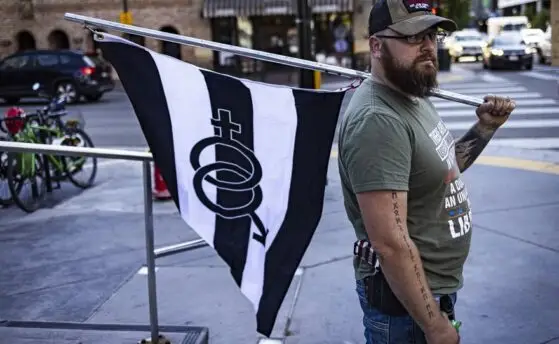 Well, now that’s television!
Well, now that’s television!
Initial thoughts: Damn, I have one big horkin’ head! I look like Kingpin from the Spider-man comics.
Oooh! Hot mic! Hot mic! We’ve got us some sibilance… sibilance. Ooh, a little feedback… hot mic!
What does that mean? You’re crazy? Oh, “wrap it up”. Got it. Me and my mouth.
Yes, I know the potency myth is ridiculous. I was setting up to debunk it.
It was a lot of fun and I look forward to taking part in more episodes. Yeah, it’s basic cable access, and yeah, I look like Jeff Gannon’s bigger brother, but hey, it’s a hobby. And who knows, if you’re not careful, you might learn something when we’re done. Hey hey hey!
All of my notes for today’s show are posted below once you …
US House Resolution 2087
The States’ Rights to Medical Marijuana Act
Sponsored by US Rep Barney Frank (D-MA)
- Reschedules marijuana as a Schedule II drug rather than Schedule I drug
- Allows doctors in medipot states to prescribe marijuana
- Prevents feds from using Controlled Substances Act (DEA) or Food, Drug and Cosmetic Act (FDA) to interfere with state-run medipot
Controlled Substances Act – Scheduled Drugs
Source: Drug Enforcement Agency – www.dea.gov
Schedule I: psilocybin (magic mushrooms), LSD (acid), MDMA (ecstasy), peyote, heroin, and marijuana
Schedule II: cocaine, codeine, methamphetamine (crank, speed), Ritalin, morphine, opium, OxyContin, and PCP (angel dust)
Schedule III: anabolic steroids, barbiturates, Marinol (synthetic THC), ketamine (Special K)
Schedule IV: Xanax, Valium, Rohypnol (roofies), Ambien
Schedule V: Robitussin
Controlled Substances Act – Schedule Definitions
Source: Drug Enforcement Agency – www.dea.gov
Schedule I: high abuse potential, no currently accepted medical use, lack of accepted safety for use under medical supervision
Schedule II: high abuse potential, currently accepted medical use, may lead to severe psych. or phys. dependence
Schedule III: moderate abuse potential, currently accepted medical use, may lead to moderate psych. or phys. dependence
Schedule IV: low abuse potential, currently accepted medical use, may lead to limited psych. or phys. dependence
Schedule V: low abuse potential, currently accepted medical use, may lead to lesser psych. or phys. dependence
Oregon Senate Bill 772 – Part I
Redefines limits & procedures in Oregon Medical Marijuana Act
Sponsored by Senator Bill Morisette (D-Dist 6)
- Plant numbers at a grow site from 3 mature/4 immature to 7 plants of any maturity
- Total usable marijuana at a grow site from 3 oz to 7 oz
- Allows exception for grow sites that only produce one crop annually to 28 plants and 80 oz of usable marijuana
- A multiple-person grow site may provide for 7 patients and produce 7 plants and 7 oz of usable marijuana each
- Redefines “mature” as 12″x12″x12″ plant
- Sets up advisory board for medipot to DHS, meet 4x year, advise DHS on admin, rules, fees of OMM
Oregon Senate Bill 772 – Part II
Redefines limits & procedures in Oregon Medical Marijuana Act
Sponsored by Senator Bill Morisette (D-Dist 6)
- Eliminates the use of an “affirmative defense” if the patient or caregiver exceeds the new 7-7-7 limits listed above
- Allows – but does not require – doctors & healthcare pros the right to dispense marijuana to patients
- Allows the patient the right to use the marijuana in a licensed health care facility
- Requires the state to track authorized patients and grow-sites and allow state/local LE access to data
- However, requires ID of the state/local LE that asks and prevents LE from doing anything but ID’ing legal patients
Oregon Senate Bill 294
Oregon Industrial Hemp Bill
Senator Floyd Prozanski (D-Dist 4)
- Legalize production of industrial hemp
- Growers must be licensed by the State
- Allows for random testing of hemp for <1% THC content
- Redefines Oregon law to separate hemp from marijuana, WRT possession and trafficking law
- Mandates max $2,500 fine for violations
Most People Don’t Support Criminality of Marijuana
Ipsos-Reid poll conducted for the Canada Institute at the Woodrow Wilson Int’l Center for Scholars in Washington, DC.
- 1000 Americans and 1000 Canadian polled
- “The conviction of possession of marijuana should always result in a criminal record.”
- 59% of Canadians, 57% of Americans disagreed
Most Oppose Legalization, Support Only Fines
CNN/Time poll, Oct. 2002, adult Americans, ±3.1%.
- Favor or oppose the legalization of marijuana?
Yes 34% (18%=1986), No 59% (78%=1986) - Legalization of marijuana in small amounts?
Yes 40%, No 51% - Marijuana – fines, not jail time?
Fines no jail 72%, Jail 19%, Both 2%, Neither 4% - Medical marijuana OK?
Yes 80%, No 17% - Ever used marijuana even once?
Yes 47% (31%=1983), No 50% (68%=1983)
Most believe Marijuana to be Least Dangerous
Zogby International, 1,109 likely voters, Jul 2002. ±3.1%.
- Regardless of legality, which is the most dangerous?
Alcohol 47%, Tobacco 28%, Marijuana 20%, Not sure 6% - Regardless of legality, which is the least dangerous?
Marijuana 38%, Tobacco 31%, Alcohol 18%, Not sure 13% - Are you more likely to support candidates who wish to stop arresting adults who smoke marijuana responsibly?
More likely 42%, Less likely 43%, No effect on voting 11%
Most believe Arresting Marijuana Smokers a mispriority
Zogby International, 1,024 likely voters, Nov 2001. ±3.2%.
- After 9/11 and with terrorism threat, should we jail nonviolent marijuana smokers?
No 61%, Yes 33% - Do you oppose DEA raids on legal state medipot co-ops?
No 67%, Yes 27%
Oregon Marijuana Laws
Source: NORML.org
- Possession <1oz = misd, no jail, $500-$1000 fine
- 1oz – 110g = felony, 10 years, $100,000 fine
- >110g = felony, variable jail and fine based on record
- Gift < 5g = misd., no jail, $500-$1000 fine
- Gift 5g – 1oz = misd., 1 year, $5,000 fine
- Sale – any = felony, 10 years, $200,000 fine
- Minor or within 1000′ of school = felony, 20 years, $300,000
- Manufacture – any = felony, 20 years, $300,000 fine
- Paraphernalia = misd., 1 year, $5,000
Marijuana Should be Rescheduled to Schedule II
New England Journal of Medicine, Jan 1997
- “Federal authorities should rescind their prohibition of the medical use of marijuana for seriously ill patients and allow physicians to decide which patients to treat. The government should change marijuana’s status from that of a Schedule I drug … to that of a Schedule II drug … and regulate it accordingly.”
Marijuana is an Effective Medical Treatment for
Nat’l Inst of Health – Workshop on Medical Utility of Marijuana 1997
nih.gov, medmjscience.org
- Pain relief (especially from nerve damage)
- Nausea (chemotherapy)
- Spasticity (Parkinson’s disease – anec)
- Glaucoma
- Movement disorders (multiple sclerosis – anec)
- Appetite stimulant (AIDS wasting, dementia)
- Possible protection against some malignant tumors
- Possible protection for nervous system
Drug Testing in the Workplace
- Expensive: $50/worker. $77,000/pos result in fed gov’t, pos rate 0.5%
- Does not verify impairment – marijuana detectable up to two months following use, 72hrs most other drugs.
The War on Drugs is now a War on Marijuana
The Sentencing Project, May 2005, sentencingproject.org
- +450,000 arrests 1990-2002, 82% marijuana, 79% possession
- Marijuana arrests now 45% of the 1.5 million annual arrests
- 734,000 marijuana arrests in 2000, only 41,000 (6%) felony
- Marijuana arrests +113% 1990-2002, overall arrests -3%;
- NYC +882% marijuana arrests, +2,461% possession
- Blacks = 14% of marijuana users, but 30% of arrests
- ~1/3 marijuana felony in state court are sent to prison
- ~1/4 in prison for marijuana = ~6,600 low-level offenders
- ~$4 billion is spent annually on the arrest, prosecution and incarceration of marijuana offenders.
- 1991 LE budget = $4.6B, 2002 = $9.5B (+107%)
Impact of the War on Marijuana
The Sentencing Project, May 2005, sentencingproject.org
- Since 1992, real price has fallen by 16%
- 1990-2002, daily use by 12th graders tripled (2.2% to 6%)
- 6% use by 12th graders was the same in 1975
- 1990, 84.4% of 12th grades easy to get marijuana
- By 2002 87.2% of 12th graders easy to get marijuana (~1975)
- FL data: +5 drug arrests = +1 incident of serious crime
- NY data: +10% marijuana sale arrests = +880 larcenies
- Asset forf. = +18% drug arrests, +20% drug arrests vs. other






